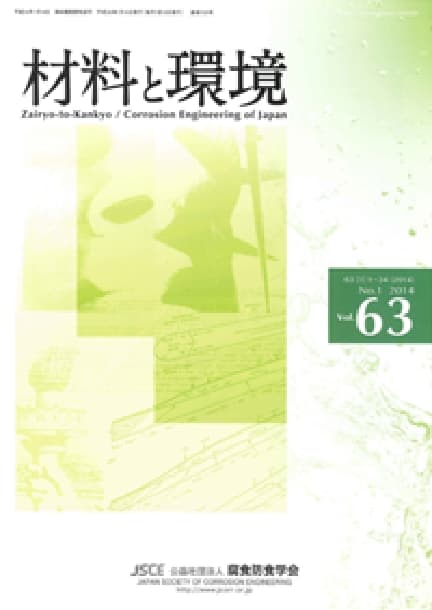材料と環境 Vol. 69 (2020), No. 1
Backnumber
-
Vol. 74 (2025)
-
Vol. 73 (2024)
-
Vol. 72 (2023)
-
Vol. 71 (2022)
-
Vol. 70 (2021)
-
Vol. 69 (2020)
-
Vol. 68 (2019)
-
Vol. 67 (2018)
-
Vol. 66 (2017)
-
Vol. 65 (2016)
-
Vol. 64 (2015)
-
Vol. 63 (2014)
-
Vol. 62 (2013)
-
Vol. 61 (2012)
-
Vol. 60 (2011)
-
Vol. 59 (2010)
-
Vol. 58 (2009)
-
Vol. 57 (2008)
-
Vol. 56 (2007)
-
Vol. 55 (2006)
-
Vol. 54 (2005)
-
Vol. 53 (2004)
-
Vol. 52 (2003)
-
Vol. 51 (2002)
-
Vol. 50 (2001)
-
Vol. 49 (2000)
-
Vol. 48 (1999)
-
Vol. 47 (1998)
-
Vol. 46 (1997)
-
Vol. 45 (1996)
-
Vol. 44 (1995)
-
Vol. 43 (1994)
-
Vol. 42 (1993)
-
Vol. 41 (1992)
-
Vol. 40 (1991)
キーワードランキング
13 Dec. (Last 30 Days)
材料と環境 Vol. 69 (2020), No. 1
ボルタンメトリーによる黄銅を含む銅材料の腐食生成物の成長機構の解析
中山 茂吉, 富永 愛子, 藤岡 寛之, 能登谷 武紀, 大堺 利行
pp. 10-16
DOI:
10.3323/jcorr.69.10抄録
Corrosion products on the brass surface were characterized by voltammetry with a high alkaline electrolyte solution (6 M KOH+1 M LiOH). In addition to copper oxides (Cu2O and CuO), zinc oxide (ZnO) was also confirmed on corroded brass surfaces. Depending on corrosion conditions, the amounts of the respective oxides formed on brass surfaces were varied. In the corrosion test in which brass is immersed in a NaCl solution (by assuming dezincification corrosion), Cu2O was selectively formed, and then grew significantly in NaCl solution at the concentration of 0.1% or less. However, when the concentration exceeded 1%, the formation of ZnO was newly confirmed. It was suggested that the formation and growth behaviors of the oxides on brass should be affected by the diffusion rate of zinc dependent on the concentration of NaCl solution.
冷却水銅配管の腐食に及ぼす堆積物の影響
山中 秀文, 永井 智之, 野中 英正, 土谷 博昭, 藤本 慎司
pp. 17-25
DOI:
10.3323/jcorr.69.17抄録
In the present study, possible effect of deposits on the corrosion of copper pipes in concentrated cooling water has been examined. It was considered that during the localized corrosion of copper pipes, the cathodic process took place on the intact sites of carbonaceous films, whereas the anodic process occurred on their defective sites. The deposits covering the defects of carbonaceous films significantly affected the corrosion of copper pipes. In particular, the presence of iron rust strongly enhanced the anodic reaction, resulting in severe corrosion. The enhanced anodic reaction was attributed to the suppressed formation of a protective oxide film most likely due to the lower pH of the areas located beneath the iron rust. It was suggested that the pretreatment to form a protective copper oxide film onto the copper pipe surface inhibited the corrosion process beneath the iron rust deposit.
論文アクセスランキング
13 Dec. (Last 30 Days)
-
大気腐食環境下における1700 MPa級調質ボルトの遅れ破壊機構
鉄と鋼 早期公開
-
Perspectives on the Promising Pathways to Zero Carbon Emissions in the Steel Industry toward 2050
ISIJ International Vol.65(2025), No.2
-
-
Factors Influencing the Bonding Phase Structure of Iron Ore Sinters
ISIJ International Vol.43(2003), No.9
-
-
-
Progress of Strip Casting Technology for Steel; Historical Developments
ISIJ International Vol.52(2012), No.12
-
Research Progress on Optimal Blending of Iron Ore Powders for Sintering
ISIJ International Vol.65(2025), No.12
-
-
Microstructures and Reduction Properties of High CaO Concentration Sintered Ore
ISIJ International 早期公開
この機能はログイン後に利用できます。
下のボタンをクリックしてください。










